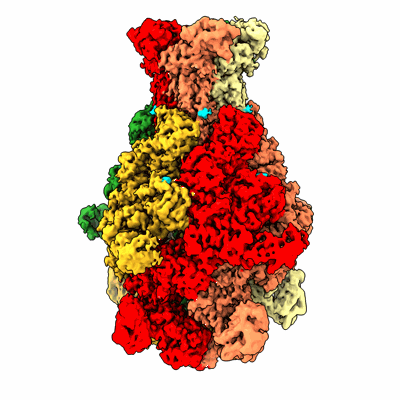EMD-16792
Photorhabdus luminescens TcdA1 prepore-to-pore intermediate, K567W K2008W mutant
EMD-16792
Single-particle3.2 Å
 Deposition: 03/03/2023
Deposition: 03/03/2023Map released: 13/03/2024
Last modified: 22/01/2025
Sample Organism:
Photorhabdus luminescens
Sample: TcdA1
Fitted models: 8cq0 (Avg. Q-score: 0.466)
Deposition Authors: Nganga PN ,
Roderer D
,
Roderer D  ,
Belyy A
,
Belyy A  ,
Prumbaum D
,
Prumbaum D  ,
Raunser S
,
Raunser S 
Sample: TcdA1
Fitted models: 8cq0 (Avg. Q-score: 0.466)
Deposition Authors: Nganga PN
 ,
Roderer D
,
Roderer D  ,
Belyy A
,
Belyy A  ,
Prumbaum D
,
Prumbaum D  ,
Raunser S
,
Raunser S 
Multistate kinetics of the syringe-like injection mechanism of Tc toxins.
Ng'ang'a PN  ,
Folz J
,
Folz J  ,
Kucher S,
Roderer D
,
Kucher S,
Roderer D  ,
Xu Y
,
Xu Y  ,
Sitsel O
,
Sitsel O  ,
Belyy A
,
Belyy A  ,
Prumbaum D
,
Prumbaum D  ,
Kuhnemuth R,
Assafa TE
,
Kuhnemuth R,
Assafa TE  ,
Dong M
,
Dong M  ,
Seidel CAM
,
Seidel CAM  ,
Bordignon E
,
Bordignon E  ,
Raunser S
,
Raunser S 
(2025) Sci Adv , 11 , eadr2019 - eadr2019
 ,
Folz J
,
Folz J  ,
Kucher S,
Roderer D
,
Kucher S,
Roderer D  ,
Xu Y
,
Xu Y  ,
Sitsel O
,
Sitsel O  ,
Belyy A
,
Belyy A  ,
Prumbaum D
,
Prumbaum D  ,
Kuhnemuth R,
Assafa TE
,
Kuhnemuth R,
Assafa TE  ,
Dong M
,
Dong M  ,
Seidel CAM
,
Seidel CAM  ,
Bordignon E
,
Bordignon E  ,
Raunser S
,
Raunser S 
(2025) Sci Adv , 11 , eadr2019 - eadr2019
Abstract:
Tc toxins are pore-forming virulence factors of many pathogenic bacteria. Following pH-induced conformational changes, they perforate the target membrane like a syringe to translocate toxic enzymes into a cell. Although this complex transformation has been structurally well studied, the reaction pathway and the resulting temporal evolution have remained elusive. We used an integrated biophysical approach to monitor prepore-to-pore transition and found a reaction time of ~30 hours for a complete transition. We show two asynchronous general steps of the process, shell opening and channel ejection, with the overall reaction pathway being a slow multistep process involving three intermediates. Liposomes, an increasingly high pH, or receptors facilitate shell opening, which is directly correlated with an increased rate of the prepore-to-pore transition. Channel ejection is a near-instantaneous process which occurs with a transition time of <60 milliseconds. Understanding the mechanism of action of Tc toxins and unveiling modulators of the kinetics are key steps toward their application as biomedical devices or biopesticides.
Tc toxins are pore-forming virulence factors of many pathogenic bacteria. Following pH-induced conformational changes, they perforate the target membrane like a syringe to translocate toxic enzymes into a cell. Although this complex transformation has been structurally well studied, the reaction pathway and the resulting temporal evolution have remained elusive. We used an integrated biophysical approach to monitor prepore-to-pore transition and found a reaction time of ~30 hours for a complete transition. We show two asynchronous general steps of the process, shell opening and channel ejection, with the overall reaction pathway being a slow multistep process involving three intermediates. Liposomes, an increasingly high pH, or receptors facilitate shell opening, which is directly correlated with an increased rate of the prepore-to-pore transition. Channel ejection is a near-instantaneous process which occurs with a transition time of <60 milliseconds. Understanding the mechanism of action of Tc toxins and unveiling modulators of the kinetics are key steps toward their application as biomedical devices or biopesticides.
